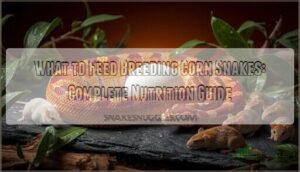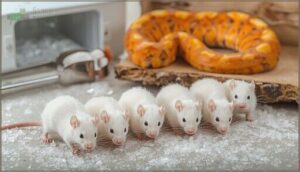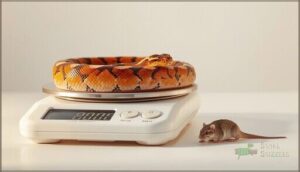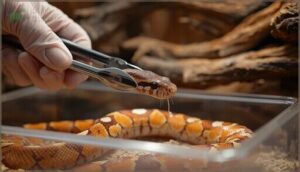This site is supported by our readers. We may earn a commission, at no cost to you, if you purchase through links.
A female corn snake that’s just laid eggs can lose up to 30% of her body weight in a single reproductive cycle, placing tremendous demands on her nutritional reserves. Breeding these snakes isn’t just about pairing compatible animals—it’s about managing energy stores, timing prey items with metabolic shifts, and understanding how nutrition interacts with brumation, gravidity, and recovery.
Feed too much during conditioning and you’ll see sluggish breeders with poor fertility. Feed too little and females won’t produce viable clutches, while males lose interest entirely. The difference between a successful breeding season and reproductive failure often comes down to what you offer in the feeding dish and when you offer it.
Your approach must account for pre-breeding weight gain, brumation fasting, post-pairing adjustments, and the intense recovery period females need after egg-laying.
Table Of Contents
- Key Takeaways
- Preparing Breeding Corn Snakes for Feeding
- Choosing The Right Prey for Breeding Adults
- Feeding Schedule for Breeding Corn Snakes
- Feeding Techniques and Best Practices
- Troubleshooting Feeding Challenges During Breeding
- Post-Breeding and Hatchling Feeding Guidelines
- Frequently Asked Questions (FAQs)
- Conclusion
Key Takeaways
- Female corn snakes can lose up to 30% of their body weight during a single reproductive cycle, making strategic feeding before, during, and after breeding essential for clutch viability and parental survival.
- Pre-breeding conditioning requires feeding appropriately sized rodents every 7-10 days for 8-10 weeks, followed by complete fasting 2-3 weeks before brumation begins, while post-brumation refeeding must start slowly with smaller prey sizes.
- Gravid females experience over 90% reduction in appetite and should receive prey every 7-12 days only if accepted, while males often refuse food entirely during active breeding—both patterns are normal hormonal responses rather than health concerns.
- Post-laying recovery demands immediate nutritional support within 48 hours for depleted females, while hatchlings should receive their first meal only after completing their initial shed at 7-10 days old to achieve 75-85% acceptance rates.
Preparing Breeding Corn Snakes for Feeding
Getting your corn snakes ready for breeding isn’t just about putting a male and female together—it starts with the right nutrition strategy weeks or even months before pairing. Your snakes need to be in peak condition, which means paying attention to their body weight, feeding schedule, and how you adjust their diet during the critical brumation period.
Let’s walk through the three key areas you’ll need to focus on to set your breeding adults up for success.
Pre-breeding Nutrition and Conditioning
Before you even consider pairing your corn snakes, proper nutrition and conditioning form the foundation for a successful breeding season. Pre-breeding female conditioning requires careful attention to body weight and prey variety, making sure your snakes reach peak reproductive fitness. Adult nutrition during this phase directly impacts clutch viability, so you’ll want to monitor every detail closely. A healthy environment, including appropriate thermal gradients, is also vital for breeding readiness.
- Feed one appropriately sized rodent every 7–10 days during the 8–10 week conditioning period
- Maintain prey items at no more than 1.5 times your snake’s mid-body diameter to prevent obesity
- Rotate between mice and quail chicks for balanced macronutrient intake and supplementation benefits
- Record weekly body weight measurements, adjusting feeding if changes exceed 5%
- Ensure continuous hydration access throughout pre-breeding preparation and before brumation fasting begins
Brumation Diet Adjustments
Once your corn snakes finish pre-breeding conditioning, you’ll need to implement pre-brumation fasting protocols at least 2–3 weeks before temperature gradual reduction begins. Adult nutrition stops completely during the brumation period, supporting natural seasonal fasts as metabolic rates drop by over 60%. Maintain hydration during brumation with weekly water changes.
Brumation is a process where corn snakes experience reduced activity.
Post-brumation refeeding starts 7–14 days after warming, using smaller prey sizes initially. Metabolic rate changes demand patience during this period.
Monitoring Body Weight and Health
After refeeding your snakes, you’ll need regular body weight monitoring every 7–14 days using digital scales accurate to 0.1 grams. Track longitudinal charting to identify weight fluctuations exceeding 10% weekly, which signal health concerns requiring immediate intervention.
Palpation techniques help with BCS interpretation—assess spine definition and muscle tone alongside hydration assessment. Proper snake health tracking during prebreeding conditioning makes certain snake growth and prevents dangerous weight loss before breeding season.
Choosing The Right Prey for Breeding Adults
Selecting the right prey for your breeding corn snakes isn’t just about feeding them—it’s about fueling their reproductive success. The size, type, and presentation of prey directly impact body condition, breeding readiness, and overall health during this demanding period.
Let’s examine your options and how to match them to your snakes’ specific needs.
Rodent Options (mice, Rats, Etc.)
When selecting rodents for your breeding corn snakes, mice remain the best choice—they’re nutritionally complete, widely available, and supply ideal calcium-to-phosphorus ratios essential for healthy egg production.
Rat alternatives work for exceptionally large adults over five feet, but their higher fat content demands careful monitoring to prevent obesity.
Frozen-thawed prey eliminates injury risk and pathogen transmission, making it the safest choice for maintaining your breeding colony’s health.
Prey Size and Weight Guidelines
Your breeding adult corn snakes need prey items weighing approximately 10% of their body weight per feeding, and this prey size guideline directly determines their health outcomes. A 200-gram female, for example, requires a single 20-gram feeder every seven to nine days. Multiple prey items can substitute larger feeders, but exceeding that body weight ratio introduces feeder size risks including regurgitation.
Breeding adult corn snakes require prey weighing 10% of their body weight to maintain optimal health and avoid regurgitation risks
Monthly monitoring of snake weight ensures your feeding frequency based on age and breeding status remains ideal, particularly when incorporating quail as prey alternatives.
Frozen-thawed Vs. Live Prey Considerations
Although frozen-thawed prey eliminates injury risks from rodent bites that can cause deep punctures requiring veterinary intervention, you’ll find the nutritional value remains comparable to live feeders. Prey selection for breeding adults should prioritize frozen vs live prey based on these factors:
- Cost effectiveness through bulk storage and consistent supply chains
- Ethical aspects preventing prey-related suffering and handler stress
- Behavioral stress reduction with proper thawing process techniques
- Nutritional supplementation options unavailable with euthanized prey fed live
Feeding Schedule for Breeding Corn Snakes
Timing your feedings correctly during breeding season can make the difference between healthy, productive adults and depleted snakes that struggle through the reproductive cycle. Males and females have different nutritional demands, and those needs shift dramatically once a female becomes gravid.
Let’s break down the specific intervals and adjustments you’ll need to maintain prime body condition throughout the breeding process.
Frequency During Breeding Season
During the breeding season, feeding frequency becomes a delicate balance between providing adequate nutrition and maintaining proper conditioning. Adult breeding females typically require weekly feedings to support egg development, while males often follow a similar schedule, although food refusal during active breeding is not unusual. Monthly weight monitoring is essential to adjust feeding intervals, as overfeeding females can lead to obesity and reproductive complications.
| Snake Type | Breeding Season Feeding Frequency |
|---|---|
| Adult Females (peak breeding) | Every 5–7 days |
| Adult Males (active breeding) | Weekly (if accepting food) |
| Underweight Adults | Every 10–14 days |
| Overweight Adults | Every 21–35 days |
| Non-Breeding Adults | Every 10–21 days |
Feeding Intervals for Males Vs. Females
Males and females require distinctly different feeding schedules during breeding season. Males generally maintain a 14-day interval, often refusing meals when actively pursuing females, while breeding females need weekly nutrition to support egg production. Weight-based adjustments help guarantee reproductive health:
- Males at breeding weight: every 14 days
- Pre-breeding female conditioning: weekly feedings
- Non-gravid females: every 7–10 days
- Underweight breeders: every 10 days
- Post-laying nutrition: resume within 48 hours
Adjustments for Gravid Females
Gravid females experience markedly reduced appetite, with feeding rates dropping by over 90% as reproductive investment increases. You’ll need to adjust feeding frequency for corn snakes to every 7–12 days during gravidity, monitoring their condition closely to avoid overfeeding risks. Prey size should never exceed the snake’s thickest body diameter, and the ideal frequency depends on individual weight tracking.
Weekly condition monitoring prevents obesity while maintaining reproductive health. Overfeeding during pregnancy correlates with metabolic disorders and increased reproductive failure, so you should reduce meal frequency as gravidity progresses rather than maintaining pre-breeding female conditioning schedules.
| Gravid Stage | Feeding Interval | Prey Adjustment |
|---|---|---|
| Early (weeks 1-3) | Every 7-10 days | Standard adult mice |
| Mid (weeks 4-6) | Every 10-12 days | Slightly smaller prey |
| Late (weeks 7+) | Optional/as accepted | Minimal to none |
| Post-laying recovery | Resume within 48 hrs | Standard portions |
Feeding Techniques and Best Practices
How you feed your breeding corn snakes matters just as much as what you feed them. Poor technique can lead to stress, injury, or feeding refusal during the critical breeding season.
Let’s walk through the essential methods that keep your snakes healthy and minimize risk during every meal.
Thawing and Preparing Frozen Prey
Proper thawing methods preserve nutrition quality and guarantee your frozen prey remains safe for feeding corn snakes. Place thawed frozen rodents in the refrigerator overnight, allowing 8-10 hours per pound, or submerge sealed bags in cold water with 30-minute water changes. Finish by warming prey in 95-100°F water for 10-30 minutes, simulating live body temperature.
Never microwave frozen prey or leave it at room temperature, as these handling techniques promote bacterial growth and compromise snake diet safety.
Safe Feeding Methods (forceps, Tongs)
Once your prey reaches ideal temperature, you’ll need the right feeding tool safety equipment. Feeding tongs or forceps let you maintain a safe 6-8 inch distance during the snake feeding process, preventing accidental bites while giving you precise control over prey presentation.
Clean your feeding corn snakes tools between uses—proper tool hygiene stops pathogen transmission between enclosures. These feeding techniques for snakes reduce stress by minimizing your direct involvement in snake handling.
Minimizing Stress and Feeding Refusal
Beyond using the right tools, your snake’s environment shapes whether it eats or refuses. Stress reduction techniques like handling only once weekly can cut feeding refusal by up to 50%. Snake hydration matters too—proper water access before meals decreases shedding-related refusal by 30%.
For successful feeding corn snakes, focus on these proven strategies:
- Maintain stable temperatures between 24-28°C to reduce snake feeding problems by 50%
- Provide hiding spots in both warm and cool zones for environmental enrichment
- Establish consistent feeding cues through regular timing and prey presentation
- Avoid handling 24-48 hours before feeding to prevent stress-related refusal
- Monitor prey size and weight carefully—items matching your snake’s mid-body width show 35% higher acceptance
Refusal analysis often reveals environmental stressors, improper prey dimensions, or recent disturbances account for 70% of feeding failures. When your snake stress and appetite seem connected, address habitat conditions first. Gradual environmental enrichment and consistent routines promote adaptability, reducing feeding refusal by approximately 35% in breeding adults.
Troubleshooting Feeding Challenges During Breeding
Breeding season brings predictable feeding disruptions that can concern even experienced keepers. Males often refuse meals entirely when focused on reproduction, while gravid females may stop eating for weeks before laying eggs.
Understanding these normal patterns—and knowing when intervention becomes necessary—keeps your breeding program on track without unnecessary stress.
Food Refusal in Breeding Males and Females
Surprisingly, up to 60% of male corn snakes refuse food during breeding season—a normal response to hormonal influences and reproductive stress. These feeding problems can last anywhere from two weeks to four months, reflecting natural breeding seasonality.
Gravid females show even more pronounced food refusal patterns, with only 6-7% containing food during egg development.
Understanding these snake nutrition needs prevents unnecessary concern when your breeders temporarily refuse food.
Environmental Factors Affecting Appetite
While hormones drive some feeding refusals, your snake’s habitat conditions play an equally important role in maintaining appetite throughout the breeding season. Temperature gradients, humidity, lighting cycles, and stress reduction all shape snake behavior and feeding willingness.
Consider these environmental factors affecting appetite:
- Temperature regulation: Corn snakes need consistent temperature gradients (warm side 85-88°F, cool side 75-80°F) for proper digestion and metabolic function
- Humidity levels: Maintain 40-50% humidity to prevent dehydration stress that suppresses feeding
- Lighting schedules: Provide 12-hour light-dark cycles to support natural circadian rhythms and hormonal balance
- Security features: Include hiding spots on both temperature zones to minimize stress-related snake health problems
Seasonal changes naturally influence metabolism, with winter temperatures slowing digestive rates from 3 days to over a week, directly impacting feeding frequency.
Encouraging Reluctant Feeders
When breeding corn snakes refuse meals, scent transfer becomes your most effective tool. Rub prey with mouse bedding or blood to trigger chemical feeding responses—studies show this increases acceptance by up to 68%.
Combine prey variation with feeding stimulation through gentle wiggling motions, which boosts strike rates by 35%.
Stress reduction through minimal handling during the week before feeding also markedly improves appetite enhancement, with acceptance rates jumping 53% among reluctant feeders.
Post-Breeding and Hatchling Feeding Guidelines
After breeding season wraps up, your corn snakes need different nutritional support depending on whether they’re recovering adults or brand-new hatchlings. Female corn snakes especially require careful feeding to restore the body condition they lost during egg production, while males benefit from a gradual return to their normal schedule.
Let’s look at the specific feeding strategies that help both generations thrive during this critical post-breeding period.
Nutrition for Recovering Adults
After your female lays her clutch, she’ll need careful nutritional support to bounce back. Offer prey amounting to no more than 10% of her body weight every 10–14 days, prioritizing frozen-thawed rodents and varied options like quail or chicks for broader nutrition.
Light calcium and multivitamin supplementation can address micronutrient gaps, while fresh water and regular soaking sessions support rehydration strategies essential for postbreeding care and adult nutrition recovery.
First Meals for Hatchlings
Timing matters when feeding baby corn snakes for the first time. You’ll want to wait until your hatchlings complete their initial shed, which generally happens 7-10 days after hatching. Offering meals too early can result in refusal rates jumping by 40%, while delays beyond two weeks can compromise neonate care and growth rates.
Key considerations for first feedings:
- Prey selection: Offer defrosted pinky mice weighing 1-2 grams—matching your hatchling’s mid-body diameter ensures safe swallowing and proper hatchling nutrition.
- Environment: Present food overnight in a quiet, enclosed space to boost feeding success by up to 20% compared to daytime attempts.
- Patience with refusal: Don’t panic if your snake refuses initially—60% of non-feeders will voluntarily accept their second offer, making early feeding refusal less concerning than you might think.
Acceptance rates for properly timed first meals range from 75-85%, though 10-15% of hatchlings may need gentle assistance. Weight gain of 1-2 grams monthly signals healthy feeding baby corn snakes, with successful eaters typically doubling their mass within 12 weeks.
Feeding Frequency and Prey Size for Young Snakes
Your young snake’s growth monitoring begins the day it accepts its first meal. Feeding frequency for hatchlings ranges from every 5–7 days, while juveniles shift to 7–10-day intervals as they mature.
Prey size should match 1–1.5 times their widest body segment—proper prey selection prevents regurgitation and aids healthy digestion rates.
Following established feeding guidelines and feeding charts ensures ideal snake nutrition throughout the corn snake diet‘s developmental stages.
Frequently Asked Questions (FAQs)
Can breeding corn snakes eat quail or chicks?
Yes, corn snakes can eat quail and chicks. Quail palatability studies confirm one-day-old quail chicks achieve top acceptance ratings.
Proper prey selection ensures feeding safety while mimicking wild diets, enhancing prey diversity and chick nutrition for breeding adults.
How does temperature affect breeding snake digestion?
Temperature regulation drives snake digestion speed—corn snakes process meals in three days at 31°C versus 5 days at 20°C, though digestion efficiency stays consistent.
During brumation fasting periods, metabolic rate impacts drop considerably below 21°C.
Should vitamins be added to breeding snake diets?
Like building a house on a shaky foundation, vitamin supplementation without proven nutrient deficiencies risks D3 toxicity. Prioritize prey quality and dietary diversity.
Blood monitoring confirms actual needs before supplementing your breeding snakes’ balanced diet.
What are signs of overfeeding in breeding snakes?
Overfeeding manifests through bloated abdomen, lethargy, digestive disorders like regurgitation, and fertility impacts in gravid females.
BCS scoring above 0, reduced activity, appetite loss, and husbandry errors—especially incorrect feeding frequency and prey size—signal dietary excess.
Do breeding snakes need water during brumation?
Even during winter cooling periods when metabolic demands drop, your snakes still need fresh water weekly.
Deprivation consequences include skin tenting and dented eye caps—hydration signs you can’t ignore throughout brumation.
Conclusion
What separates thriving breeders from those that struggle through each cycle? Precision in what to feed breeding corn snakes transforms reproductive outcomes. You’ve seen how timing prey items around brumation, adjusting portions for gravid females, and prioritizing post-lay recovery directly influence clutch viability and parental health.
When you match feed size to metabolic demand and recognize refusal as a biological signal rather than defiance, you’re no longer guessing—you’re managing energy budgets that determine whether your breeding program succeeds or stalls.
- https://exoticskeeper.com/blog/corn-snakes-in-the-wild-amp-history-of-captive-breeding/
- https://talis-us.com/blogs/news/corn-snake-feeding-guide
- https://raw-petfood.pl/en/blog/would-a-corn-snake-eat-a-hatchling-description-of-the-study-1705327645.html
- https://snakeinsider.com/corn-snake-feeding-chart/
- https://reptifiles.com/corn-snake-care-guide/corn-snake-food/














